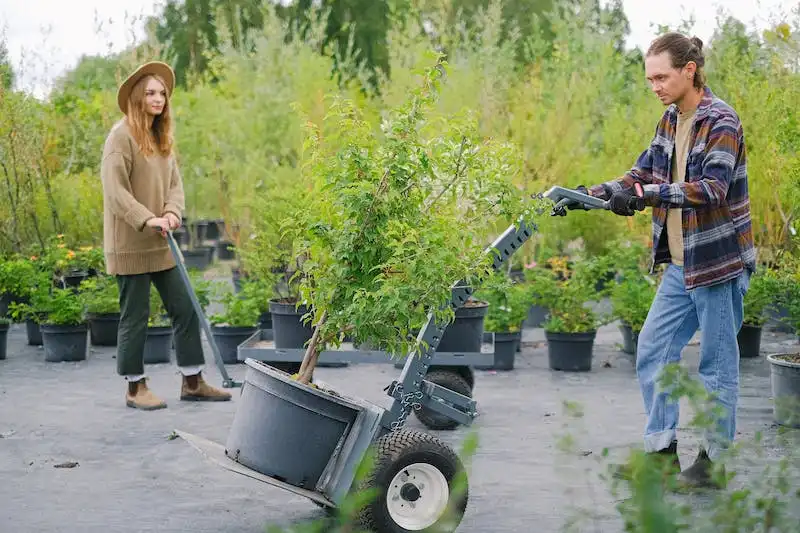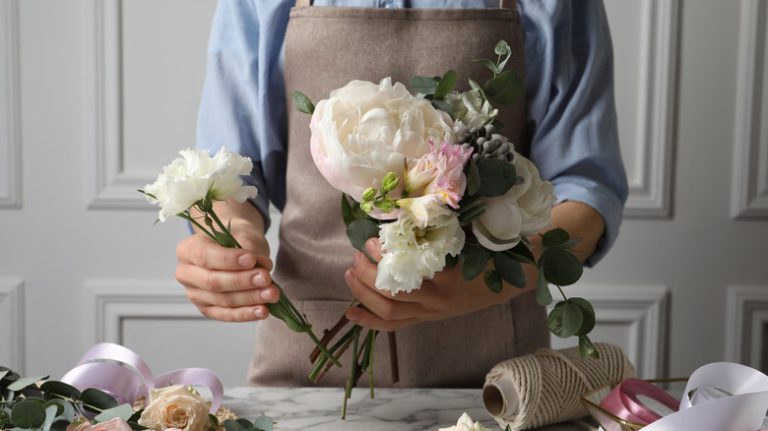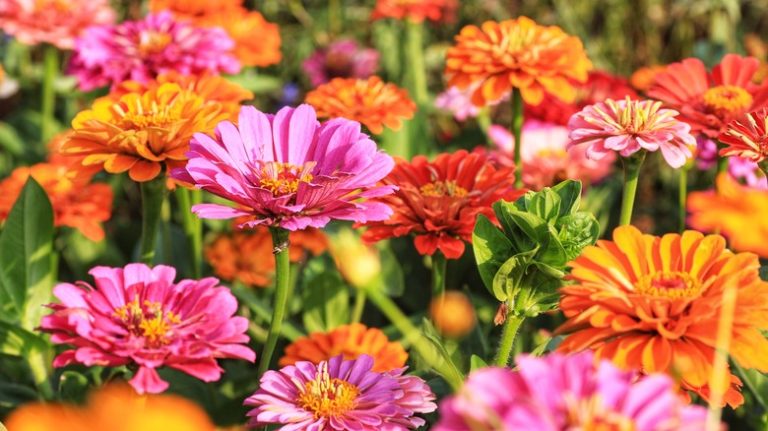Dahlias are a popular flower and a favorite choice among many gardeners. These colorful flowers come in a wide variety of shapes, sizes, and colors, making them a versatile and attractive addition to any garden.
One of the great benefits of dahlias is that they attract beneficial insects such as bees and butterflies. These insects help to pollinate the flowers and keep the garden ecosystem in balance. Another interesting fact about dahlias is that they were once used by the fox as a measure of the months. The fox would bury dead dahlias to mark the passing of time.
When it comes to planting dahlias, timing is crucial. Dahlias should be planted in late spring or early summer, after the last frost has passed. They prefer well-drained soil and a sunny location. Before planting, it is important to prepare the soil by loosening it and adding organic matter. This will help to improve drainage and provide essential nutrients for the plants.
Once planted, dahlias require regular watering and fertilizing to thrive. They are heavy feeders and should be fertilized every three to four weeks with a balanced fertilizer. Deadheading, pinching, and pruning are also important tasks to keep dahlias looking their best. Deadheading helps to promote additional blooms, while pinching and pruning help to control the size and shape of the plants.
Dahlias are also easy to propagate, either by dividing the tuberous roots or by growing them from seed. Dividing clumps of plants every two to three years will help to ensure healthy growth and abundant blooms. When it comes to growing dahlias from seed, it is necessary to start them indoors about 12 weeks before planting them outside. This will allow the seedlings to grow and develop strong root systems before transplanting.
One of the most appealing features of dahlias is the wide range of colors they come in. From vibrant reds and oranges to soft pinks and purples, there is a dahlia for every taste. Some varieties even feature multicolored or variegated flowers. Dahlias can be used as cut flowers and make a stunning addition to any floral arrangement.
When it comes to harvesting dahlias, it is best to wait until the flowers have fully matured. The flowers should be cut early in the morning or late in the evening when they are at their freshest. Removing any leaves from the stems will help to prevent the water from wilting. Dahlias can be stored in a cool, dry place until ready to use.
In conclusion, dahlias are a beautiful and versatile flower that can add a pop of color to any garden. Whether grown from tuberous roots or from seed, dahlias are relatively easy to grow and care for. With proper planting, watering, and fertilizing, dahlias will reward the gardener with stunning blooms throughout the summer months.
Dahlias
Dahlias are beautiful flowering plants that can brighten up any garden. They are known for their stunning blooms, which come in a wide range of colors and shapes. Dahlias are easy to grow and require minimal maintenance, making them a favorite among gardeners.
When it comes to planting dahlias, there are a few key steps to follow. First, you need to choose a sunny location with well-drained soil. Dahlias prefer slightly acidic to neutral soil pH. Before planting, make sure to prepare the soil by loosening it and adding organic matter to improve drainage.
The next step is to plant the dahlia bulbs. Dig a hole that is about 6-8 inches deep and place the bulb in the hole with the ‘eyes’ facing up. Cover the bulb with soil, leaving about an inch of space above the ground. Water the newly planted bulb thoroughly.
To encourage healthy growth and blooming, it is important to fertilize dahlias regularly. Use a balanced fertilizer every three to four weeks during the growing season. Be careful not to over-fertilize, as this can lead to excessive foliage growth at the expense of blooms.
As dahlias grow, they may need staking for support. This is especially true for larger varieties that produce heavy blooms. Use stakes or cages to prevent the plants from bending or breaking under the weight of their flowers.
Dahlias are also prone to diseases and pests. Keep an eye out for common problems such as powdery mildew and aphids. If you notice any signs of disease or infestation, take appropriate measures to control the issue. Regularly inspect the leaves for any signs of discoloration or damage.
In the fall, after the first frost, dahlias should be dug up and stored for overwintering. Carefully dig up the tubers, taking care not to damage them. Cut back the foliage to about 2 inches above the tubers. Let the tubers dry in a cool, dry place for a few weeks before storing them in a frost-free location.
Overall, dahlias are a versatile and dazzling addition to any garden. With the right care and attention, these plants can provide months of beautiful blooms. Whether you’re a seasoned gardener or a beginner, dahlias are sure to impress with their vibrant colors and showy flowers.
Footer Start
When it comes to dahlias, there are many different varieties and techniques that growers can follow to ensure the best results. The direct rate of acceptable growth can vary depending on factors such as temperature, moisture, and humidity. Dahlias are a family of tender flowering plants that grow from tubers. The stems can be quite long, and the leaves are usually green and loose. Some popular varieties include the white swan, Elise, Island Breeze, Katu, Ayo, and many more.
One important procedure in dahlia gardening is digging and dividing the tubers. This is typically done in the late winter or early spring when the foliage starts to turn brown and wilt. By dividing the tubers, growers can create new plants and encourage higher rates of blooming. Another method of propagating dahlias is through cuttings, which can be taken from the sprouted stems. Pinching back the stems can also promote bushier growth and more abundant blooms.
When it comes to caring for dahlias, it’s important to provide them with the proper conditions. Dahlias prefer a well-draining soil that is rich in organic matter. They thrive in full sun but can tolerate some light shade. Frost is a major threat to dahlias, so it’s essential to protect them from frost by covering them or bringing them indoors. Dahlias are also susceptible to pests such as slugs and deer, so gardeners should take necessary precautions to prevent damage.
Diseases such as powdery mildew can also affect dahlias, especially in humid or damp conditions. To prevent mildew, make sure to provide good air circulation around the plants and avoid overhead watering. Disbudding, or removing the side buds, can also help redirect energy to the main bud and promote larger blooms.
In conclusion, dahlias are beautiful and versatile flowers that can be enjoyed by gardeners of all skill levels. By following the proper techniques for planting, caring, and harvesting, gardeners can enjoy a bountiful and vibrant dahlia garden.
Contact Longfield Gardens
If you have any questions or need assistance with your dahlias, don’t hesitate to contact Longfield Gardens. Our knowledgeable staff will be happy to assist you.
Here are a few points to consider when contacting us:
Planting and Care: Whether you’re a new gardener or have years of experience, we can provide you with the necessary information to ensure your dahlias thrive. From planting tips to watering advice, we have you covered.
Choosing the Right Dahlias: With such a wide range of dahlias available, it can be overwhelming to know which ones to choose. Our experts can help you select dahlias that will best suit your needs, whether you’re looking for upright, compact, or long-stemmed varieties.
Pest and Disease Control: Dahlias are susceptible to various pests and diseases, such as slugs and rot. We can provide you with tips on how to prevent and manage these problems, ensuring your dahlias stay healthy and beautiful.
Dividing and Rooting: If you’re interested in multiplying your dahlias or want to learn more about dividing and rooting, our team can guide you through the process. We’ll explain when and how to divide dahlias, depending on your planting zone and the health of your plants.
Fertilizing and Feeding: Proper fertilization is essential for promoting healthy growth and abundant blooms. We can recommend fertilizers that are suitable for dahlias and provide instructions on how to apply them.
Longfield Gardens Picks: If you’re not sure which dahlias to choose, we can share our top picks for the season. Our recommendations are based on our expertise and the feedback we receive from growers.
Ordering and Shipping: If you’re interested in buying dahlias, we offer a convenient online ordering system. We carefully package the dahlias and ship them directly to your doorstep, ensuring they arrive in perfect condition.
Longfield Gardens Guarantee: We stand by the quality of our dahlias and offer a guarantee. If you’re not satisfied with your purchase, please contact us within a specified timeframe.
So don’t hesitate to reach out to Longfield Gardens for all your dahlia-related questions and needs. We’re here to help you grow the most beautiful dahlias possible!
Shop
When it comes to shopping for dahlias, there are a few important things to keep in mind. First, consider the time of year. Dahlias are typically planted in the spring, so the best time to shop for them is in the months leading up to planting season.
Next, think about the size of dahlias you want to grow. Dahlias come in a wide range of sizes, from dwarf-size varieties to ones that can reach several feet in height. Consider the space you have available in your garden or planting area, and choose dahlias accordingly.
When selecting dahlias, look for healthy plants with green foliage. Avoid any plants with signs of pests or disease. The stems should be sturdy and the leaves should be full and lush. Healthy dahlias will have a well-developed root system.
Before planting, prepare the location where you will be growing your dahlias. Choose a sunny spot with well-drained soil. It is also a good idea to amend the soil with organic matter or compost to help with drainage and fertility.
When planting your dahlias, dig holes that are about 2 inches deeper than the length of the seed or cutting you are planting. Place the seed or cutting in the hole, cover with soil, and water well. Dahlias should be spaced about 2 to 4 feet apart in the garden or in larger clumps if grown in pots or containers.
As your dahlias grow, you will need to provide support for the stems. Use stakes or other supports to keep the plants upright. You may also need to stake the flower heads to keep them from drooping.
To encourage fuller growth and more blooms, you can pinch off the tips of the plants when they are about 12 inches tall. This will help to promote branching and produce more flowers.
Fertilize your dahlias every 2 to 3 weeks throughout the growing season to keep them healthy and blooming. Use a balanced fertilizer with equal amounts of nitrogen, phosphorus, and potassium.
To keep your dahlias free from pests and diseases, keep a watchful eye for any signs of trouble. If you notice any insect pests, contact your local garden center for advice on how to control them.
When your dahlias are in full bloom, you can start harvesting the flowers. Cut the stems at an angle, about 1 inch above the base of the plant. This will help the flowers last longer in floral arrangements.
At the end of the growing season, you will need to prepare your dahlias for overwintering. In colder climates, dahlias will need to be dug up and stored indoors to protect them from freezing temperatures. Cut the stems back to about 6 inches above the ground and carefully dig up the tubers. Clean off any excess soil and let them dry for a few days before storing them in a cool, dry location.
With a little practice and a green thumb, dahlias can be a dazzling addition to any garden or home. Take your time to choose the right varieties, provide the necessary care, and enjoy the beautiful blooms throughout the growing season.




